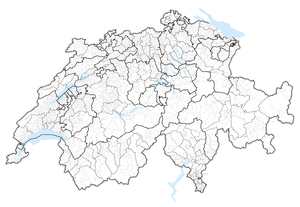Districts of Switzerland
In contrast to centrally organised states, in the federally constituted Switzerland each canton is completely free to decide its own internal organisation. Therefore, there exists a variety of structures and terminology for the subnational entities between canton and municipality, loosely termed districts (i.e. Urban Administration Districts).
Most cantons are divided into Bezirke (German for districts, singular Bezirk). They are also termed Ämter (Lucerne, singular Amt), Amtsbezirke (Bern, Amtsbezirk), district (in French) or distretto (Ticino and part of Graubünden). The Bezirke generally provide only administration and court organization. However, for historical reasons districts in cantons Graubünden and Schwyz are their own legal entities with jurisdiction over tax and often have their own Landsgemeinde.
Seven of the 26 cantons – Uri, Obwalden, Nidwalden, Glarus, Zug, Basel-City and Geneva – have always existed without the district level of government. An eighth one, Appenzell Innerrhoden, uses no intermediate level either, but calls its lowest-level subdivisions Bezirke, although they are functionally equivalent to municipalities elsewhere.
A number of further cantons are considering (or have already decided) an abolition of the district level in the future: Appenzell Ausserrhoden, Schaffhausen, Lucerne, St. Gallen, Schwyz in 2006 voted on its abolition, but voted in favour of keeping the division. Bern in 2006 decided a reduction of its 26 districts to five administrative regions. Vaud decided a reduction from 19 to 10 districts. Valais is planning a similar reduction and in Thurgau, a reduction of eight to four districts is under discussion.
For further updated about this districts, see: Population size and population composition – Data, indicators: Cantons, communes [1] or Permanent resident population by age, canton, district and commune 2010-2013.[2]
Zürich

The Canton of Zürich is divided into 12 districts (German: Bezirke)containing an estimated 641650 people:
- Affoltern with capital Affoltern am Albis
- Andelfingen with capital Andelfingen
- Bülach with capital Bülach
- Dielsdorf with capital Dielsdorf
- Dietikon with capital Dietikon
- Hinwil with capital Hinwil
- Horgen with capital Horgen
- Meilen with capital Meilen
- Pfäffikon with capital Pfäffikon
- Uster with capital Uster
- Winterthur with capital Winterthur
- Zürich comprises the city of Zürich
Bern

The Canton of Bern is divided in five regions: Berner Jura, Seeland (with two subregions, Biel/Bienne and Seeland), Bern-Mittelland, Oberland (with subregions Thun, Obersimmental-Saanen, Frutigen-Niedersimmental, Interlaken-Oberhasli) and Emmental-Oberaargau (with two subregions, Emmental and Oberaargau) The current division has taken effect on 1 January 2010, based on a 2006 decision to abolish the former system of districts.
On 1 January 2010, the 26 administrative districts (Amtsbezirke) were combined into 10 new administrative districts (Verwaltungskreise):[3]
- Bern-Mittelland with capital Ostermundigen, made up of all or part of the former districts of Bern, Fraubrunnen, Konolfingen, Laupen, Schwarzenburg and Seftigen
- Biel/Bienne with capital Biel/Bienne, made up of all of the former district of Biel and about half of the former district of Nidau
- Emmental with capital Langnau im Emmental, made up of all or part of the former districts of Burgdorf, Signau and Trachselwald
- Frutigen-Niedersimmental with capital Frutigen, made up of all or part of the former districts of Frutigen and Niedersimmental
- Interlaken-Oberhasli with capital Interlaken, made up of all or part of the former districts of Interlaken and Oberhasli
- Jura bernois with capital Courtelary, made up of all or part of the former districts of Courtelary, Moutier and La Neuveville
- Oberaargau with capital Wangen an der Aare, made up of all or part of the former districts of Aarwangen and Wangen
- Obersimmental-Saanen with capital Saanen, made up of all of the former districts of Obersimmental and Saanen
- Seeland with capital Aarberg, made up of all or part of the former districts of Aarberg, Büren, Erlach and Nidau
- Thun with capital Thun, made up of all of the former administrative district of Thun
Lucerne
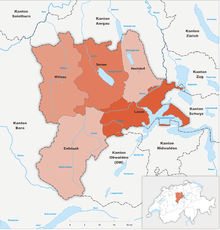
The Canton of Lucerne used to be divided into 5 Ämter:
- Entlebuch with capital Schüpfheim
- Hochdorf with capital Hochdorf
- Luzern with capital Luzern
- Sursee with capital Sursee
- Willisau with capital Willisau
These were abolished with the new cantonal constitution of 2007, although they will continue to be used as electoral districts.
Schwyz
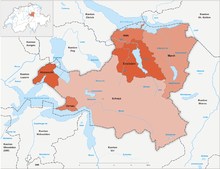
The Canton of Schwyz is divided into 6 districts:
- Einsiedeln including only the municipality of the same name
- Gersau including only the municipality of the same name
- Höfe with capital alternating between Wollerau and the village of Pfäffikon
- Küssnacht including only the municipality of the same name
- March with capital Lachen
- Schwyz with capital Schwyz
Fribourg
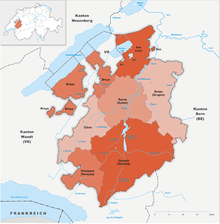
The Canton of Fribourg is divided into 7 districts:
- Broye with capital Estavayer-le-Lac
- Glâne with capital Romont
- Gruyère with capital Bulle
- Sarine with capital Fribourg
- See/Lac with capital Murten/Morat
- Sense with capital Tafers
- Veveyse with capital Châtel-Saint-Denis
Solothurn
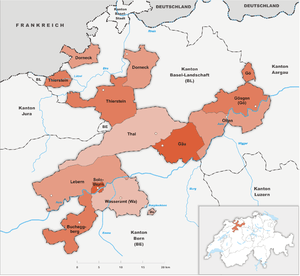
From 2005, Solothurn's ten districts are merged pairwise into five electoral districts, termed Amtei. From 2005, districts only have a statistical meaning.
- Bucheggberg, Amtei Wasseramt-Bucheggberg
- Dorneck, Amtei Dorneck-Thierstein (unofficially Schwarzbubenland)
- Gäu, Amtei Thal-Gäu
- Gösgen, Amtei Olten-Gösgen (unofficially Niederamt)
- Lebern, Amtei Solothurn-Lebern
- Olten, Amtei Olten-Gösgen
- Solothurn, Amtei Solothurn-Lebern
- Thal, Amtei Thal-Gäu
- Thierstein, Amtei Dorneck-Thierstein
- Wasseramt, Amtei Wasseramt-Bucheggberg
Basel-Landschaft
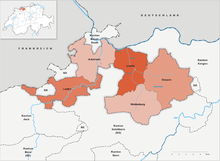
Basel-Landschaft is divided into 5 districts:
- Arlesheim with capital Arlesheim
- Laufen with capital Laufen
- Liestal with capital Liestal
- Sissach with capital Sissach
- Waldenburg with capital Waldenburg
St. Gallen

The canton abolished the district level in 2003, but it remains divided into eight constituencies (Wahlkreise) without administrative significance:
- Rheintal with capital Altstätten
- Rorschach with capital Rorschach
- Sarganserland with capital Sargans
- See-Gaster with capital Rapperswil-Jona
- St. Gallen with capital St. Gallen
- Toggenburg with capital Lichtensteig
- Werdenberg with capital Buchs
- Wil with capital Wil
Graubünden
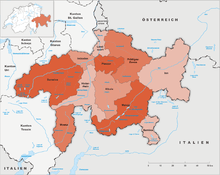
Graubünden is divided into 11 districts:
- Albula with capital Tiefencastel
- Bernina with capital Poschiavo
- Hinterrhein with capital Thusis
- Imboden with capital Domat/Ems
- Inn with capital Scuol
- Landquart with capital Landquart
- Maloja with capital Samedan
- Moesa with capital Roveredo
- Plessur with capital Chur
- Prättigau/Davos with capital Davos
- Surselva with capital Ilanz
Aargau

Aargau is divided into 11 districts:
- Aarau with capital Aarau
- Baden with capital Baden
- Bremgarten with capital Bremgarten
- Brugg with capital Brugg
- Kulm with capital Unterkulm
- Laufenburg with capital Laufenburg
- Lenzburg with capital Lenzburg
- Muri with capital Muri
- Rheinfelden with capital Rheinfelden
- Zofingen with capital Zofingen
- Zurzach with capital Zurzach
Thurgau
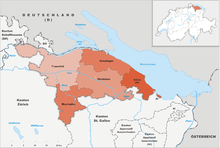
Thurgau is divided into five districts (eight prior to 2011) and each is named after its capital:
- Arbon with capital Arbon
- Frauenfeld with capital Frauenfeld
- Kreuzlingen with capital Kreuzlingen
- Münchwilen with capital Münchwilen
- Weinfelden with capital Weinfelden
Ticino
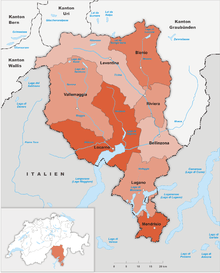
Ticino is divided into 8 districts:
- Bellinzona with capital Bellinzona
- Blenio with capital Acquarossa
- Leventina with capital Faido
- Locarno with capital Locarno
- Lugano with capital Lugano
- Mendrisio with capital Mendrisio
- Riviera with capital Biasca
- Vallemaggia with capital Cevio
Vaud

Vaud is divided into 10 districts:
- Aigle with capital Aigle
- Broye-Vully with capital Payerne
- Gros-de-Vaud with capital Echallens
- Jura-North Vaudois with capital Yverdon-les-Bains
- Lausanne with capital Lausanne
- Lavaux-Oron with capital Cully
- Morges with capital Morges
- Nyon with capital Nyon
- Riviera-Pays-d'Enhaut with capital Vevey
- Ouest Lausannois with capital Renens
Valais
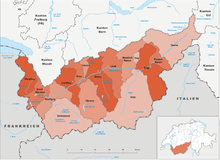
Valais is divided into 13 districts:
- Brig with capital Brig-Glis
- Conthey with capital Conthey
- Entremont with capital Sembrancher
- Goms with capital Münster-Geschinen
- Hérens with capital Evolène
- Leuk with capital Leuk
- Martigny with capital Martigny
- Monthey with capital Monthey
- Saint-Maurice with capital Saint-Maurice
- Sierre with capital Sierre
- Sion with capital Sion
- Visp with capital Visp
The district of Raron is divided into:
- Östlich Raron with capital Mörel-Filet
- Westlich Raron with capital Raron
Neuchâtel
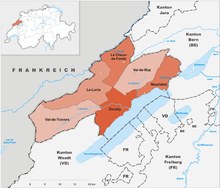
The Canton of Neuchâtel is divided into 6 districts:
- Boudry with capital Boudry
- La Chaux-de-Fonds with capital La Chaux-de-Fonds
- Le Locle with capital Le Locle
- Neuchâtel with capital Neuchâtel
- Val-de-Ruz with capital Cernier
- Val-de-Travers with capital Val-de-Travers
Jura
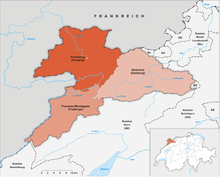
The Canton of Jura is divided into 3 districts:
- Delémont with capital Delémont
- Porrentruy with capital Porrentruy
- Franches-Montagnes with capital Saignelégier
Schaffhausen
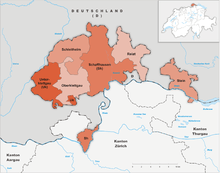
The Canton of Schaffhausen is divided into 6 districts:
- Stein with capital Stein am Rhein
- Schaffhausen with capital Schaffhausen
- Schleitheim with capital Schleitheim
- Oberklettgau with capital Neunkirch
- Unterklettgau with capital Hallau
- Reiat with capital Thayngen
Lucerne

The Canton of Lucerne is divided into 5 districts:
- Lucerne with capital Luzern
- Hochdorf with capital Hochdorf
- Sursee with capital Sursee
- Willisau with capital Willisau
- Entlebuch with capital Schüpfheim
St. Gallen

The Canton of St. Gallen is divided into 8 districts (wahlkreis):
- Rheintal with capital Altstätten
- Rorschach with capital Rorschach
- Sarganserland with capital Sargans
- See-Gaster with capital Rapperswil-Jona
- St. Gallen with capital St. Gallen
- Toggenburg with capital Lichtensteig
- Werdenberg with capital Buchs
- Wil with capital Wil
Appenzell Ausserrhoden
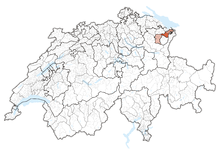
The Canton of Appenzell Ausserrhoden is divided into 3 districts:
Appenzell Innerrhoden
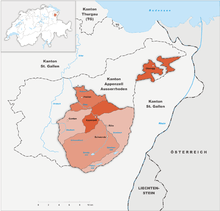
In Appenzell Innerrhoden districts are the lowest administrative division as the canton has no municipalities (except for the Feuerschaugemeinde, a special-purpose municipality for the town of Appenzell). The districts are functionally equivalent to municipalities elsewhere in Switzerland, and are generally shown as municipalities on maps etc.
The Canton is divided into 6 districts:
See also
Notes and references
- ↑ Population size and population composition – Data, indicators: Cantons, communes. (Report). Federal Statistical Office. 2014. nden. Retrieved 15 August 2015.
- ↑ Permanent resident population by age, canton, district and commune 2010-2013. (Report). Federal Statistical Office FSO. 2011. nden. Retrieved 15 August 2015.
- ↑ Amtliches Gemeindeverzeichnis der Schweiz, Mutationsmeldungen 2009 / Répertoire officiel des communes de Suisse, Mutations 2009 / Elenco ufficiale dei Comuni della Svizzera, Mutazione 2009 (PDF) (Report). Federal Statistical Office. 2009. nden. Retrieved 6 March 2010.
